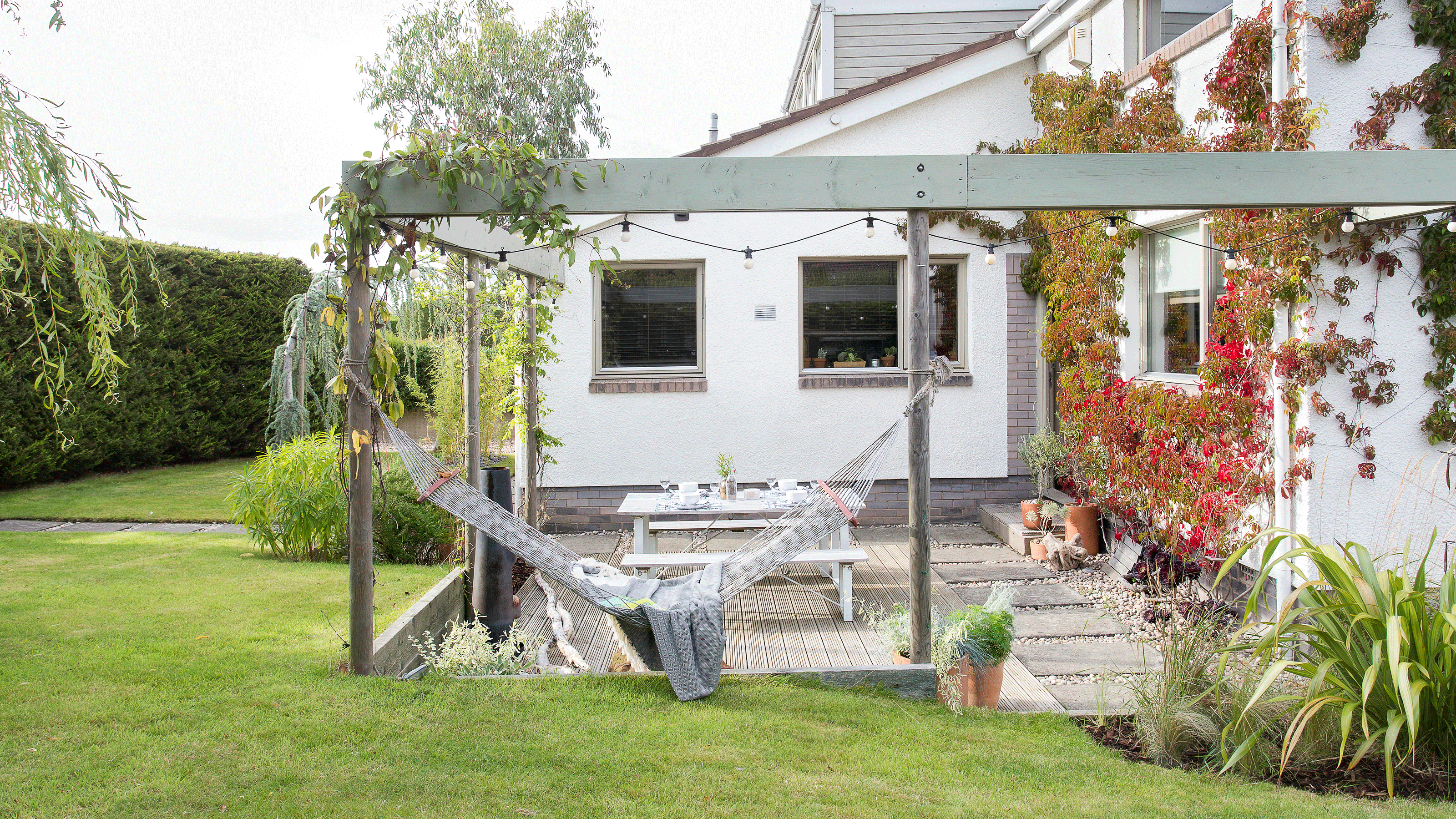Lawn care tips – 10 ways to help your garden's grasses thrive
Experts share tips on how to perfect your lawn in time for summer

With summer just around the corner, now is the perfect time to start giving our lawn some extra care and attention. The best lawn care tips will help to perfect your garden's grass so that it is the perfect setting for family barbecues and summer soirees.
Spring is the ideal time to start looking into lawn care tips, as our grasses naturally go through a renovation period at this time following the cold winter season. But for our lawn ideas to really look their best, a helping hand goes a long way. And some of the most effective lawn care tips are also the least intensive in terms of time and money.
'A healthy lawn is a happy lawn that can be enjoyed year after year,' says Timothy Greene, Grass Expert, iCANLAWN.com. 'And keeping your lawn healthy doesn’t have to be a difficult job.'
So that your lawn can thrive this year, we've put together this essential guide covering all the best lawn care tips and tricks that gardening experts swear by.

Lawn care tips – 11 ways to improve garden turf
'Having a beautiful, vibrant lawn is a great way to add value and beauty to your property and create a beautiful and relaxed setting,' says Josh Novell, Director, Polhill Garden Centre. 'To achieve a healthy lawn, there are several steps you can take.'
For you to nurture a lawn that is healthy, happy and thriving, we've pulled together 11 of the best lawn care tips. Packed full of expert advice, our guide will tell you everything you need to know in order to achieve a perfectly manicured lawn that will be the envy of all your neighbours.
1. Speed up recovery from the winter season

'Spring is a great time to feed your lawn to help it recover after winter and provide all the nutrients needed during the growing season for thick, dense grass,' says Jamie Shipley, Gardening Expert and MD, Hedges Direct.
Learning how to restore your garden after winter can transform your grass from dry and damaged to well nourished and healthy. Applying a fertiliser is the easiest way to do this. Make sure you have mowed, aerated, and removed any weeds or leaves from your lawn before fertilising. Then spray a liquid fertiliser, like the Miracle-Gro EverGreen Spray & Feed, 1 litre for £12.99 at Amazon, on to your lawn. Follow up with a light sprinkling of water to help it absorb into the soil.
'And applying fertiliser in autumn will prepare your grass for harsh weather conditions in winter, as well as increase recovery time if damaged,' Jamie adds.
2. Get rid of leaves, weeds and moss

Removing debris, moss and dead 'thatch' from your lawn is the first job. 'Using a rake to remove debris and dead grass disturbs the top layer of soil, so you can plant new grass seed to make your lawn look thicker and greener', says Josh from Polhill Garden Centre.
If you're working with small garden ideas, use a spring-tined rake and a bit of physical effort. For larger areas consider hiring a scarifyer with a motor, which will pull all the moss and dead stuff out of the lawn, allowing light and air to get in. The debris will still have to be raked up and removed.
Clear leaves with a rake as soon as they fall so they don’t rot and damage grass. For clearing agricultural pests, there are a few ways you can learn how to kill weeds, either by hand, using a traditional daisy grubber, or a chemical treatment. Chemicals are less effort but make sure you follow the instructions to the letter to avoid over-treating and unnecessary damage.
Use a spring-tine rake to remove moss (called scarifying). It’s hard work but it stops the moss from smothering the grass, giving it a chance to grow. Only scarify in spring, otherwise, you can cause lasting damage.
3. Spruce up your lawn edges

'Sometimes a mower can’t reach the edges of your garden, especially if you have a lawn that is against a wall or fence', Josh says. 'You may need to dedicate some time and use some gardening shears to trim down the edges.'
Keep your garden edging ideas neat by using a half-moon edger a couple of times a year. This Lawn Edge Gardening Tool, £12.99 at B&Q, will define the line between flower beds and your lawn, making your whole garden look tidier instantly.
'Edging your lawn is a great way to instantly improve your lawn's general appearance', says Steve Chilton, Gardening Expert, Leisure Bench. 'It helps keep your garden looking neat and tidy, and is particularly good for shaping small gardens.'
4. Adjust the cutting height with care
If you have 'let the garden grow' in colder months and your lawn is looking a little unkempt come spring, then fear not. You can gradually decrease the cutting height on your best lawnmower over the weeks each time to reach your desired grass length. It's also important to know when to start cutting grass after winter; wait until the frost has completely gone, or the grass might not be able to grow back properly.
'Ensure your mower is on a setting that will cut around 25% of growth, and leaves around three centimetres of grass length,' says Jamie from Hedges Direct. 'If your lawn is cut too short, there is less leaf area to take in oxygen and sunlight, slowing root development, and the blade could also damage the crowns of the grass plants.'
As the temperature starts to increase, you can then start to cut more grass when you mow the lawn. 'Cut grass with the lawn mower blades set high for the first few times, then use a good lawn feed to help your lawn look its best,' says Marcus Eyles, Horticultural Director, Dobbies.

5. Improve drainage
Where lawns have become very compacted and are not draining well, use a lawn aerator; a very simple tool that has hollow prongs you push into the lawn like a fork. This will remove small plugs of soil which can then have lawn sand brushed into them. This will help the lawn to drain faster.
This can also be done using a garden fork pushed into the lawn and wiggled around to break the soil and reduce the compaction. If you have a wet, soggy lawn, plunge a fork into the ground all over your patch (called aerating). Go as deep as possible every 30cm or so, and it will help with drainage and encourage grass root growth for generally healthier grass.
'This simple process can rescue your lawn if it’s been suffering from compacted soil, as it improves drainage and the flow of nutrients, air, and water,' Jamie explains.
6. Repair patchy grass areas

The best lawn care tips involve planting seeds for new grass to grow in damaged areas. Rake up the earth until it’s crumbly, then sow seed according to packet instructions. Water the area well and don’t walk on it for several weeks.
'Sow new lawns or repair bare patches from April if weather allows, on ground that has been pre-prepared, levelled and firmed,' Marcus from Dobbies advises. 'If you are laying new turf, leave undisturbed for a few weeks to allow time for new roots to establish.'
'You can spread the grass seeds by hand or there are grass seed-spreading tools that you can use,' says Josh from Polhill Garden Centre. 'It all depends on the surface area of your lawn and how meticulous you want it to be.'
7. Top dress your turf
Top-dressing is a mix of soil, sand and well-rotted compost, but you can also buy pre-mixed bags. For a really well-kept lawn, brush some top-dressing over the grass at least twice a year; once in spring, and once in autumn, to correspond with the lawn's natural renovation periods.
Buying top-dressing in bulk, like this Rolawn Lawn Top Dressing Bulk Bag, 500L for £160 at Wickes, means you can keep it in your shed for years to come, and dip back into it at the appropriate times. Apply two lots, allowing a few days between each to let the mixture settle into any holes and dips. This will also encourage grass to thicken and put down more roots.
8. Give the grass a feed

'You should feed your lawn in the same way that you'd feed your plants and flowers,' says Steve from Leisure Bench. 'The best time to feed your lawn is just before it rains. This is so that when it does rain, the feed gets washed right down to the roots.'
Lawn feeds encourage grass to ‘green up’ and look healthy. Once you start feeding lawns they become dependent on it, so it’s important you don’t stop. Start in spring and get into a weekly routine during the main growing season but don’t over-feed as this can cause scorching.
'If you want to promote wildlife in your garden avoid using weed killers on the lawn and allow clovers, bugle, and tiny trefoils to populate the lawn, all of which give bees something to feed on,' says Craig Roman from Dobbies.
9. Give grass a drink in dry spells
With temperatures in peak summer soaring in recent years, grass can often wind up yellow, parched and thirsty. Waiting for the next rainfall isn't enough if you want your lawn to look and stay healthy during dry spells, so the experts recommend to manually water it instead.
If you're wondering can you water grass in the sun, the answer is yes, but you shouldn't do it too frequently. 'Over-watering your lawn can lead to damage as it becomes waterlogged and drowned,' Steve explains.
'It’s important to water your lawn deeply and less frequently to encourage deep roots,' Jack Sutcliffe, Co-founder, Power Sheds expands. 'This will help your lawn to be more drought-tolerant and well-hydrated.'
10. Keep on top of mowing

'Mowing your lawn regularly is one of the most important aspects of lawn care,' says Jack. 'Not only does it keep your lawn looking neat and tidy, but it also promotes healthy growth.'
Mowing the lawn may not be the most loved chore for many of us, but it's important not to skip it if you're implementing all of the above lawn care tips.
'I generally recommend doing this once every two weeks or so depending on the growth rate of your particular type of turfgrass,' says Muhammed Haq, Founder, Norfolk Garden Sheds. 'When mowing, always use sharp blades as dull blades will tear rather than cut through the grass which can cause damage to your lawn over time as well as lead to brown patches throughout your yard.'
How do you maintain a beginner lawn?
If you're new to garden work, lawn care tips can feel a little overwhelming and it's difficult to know where to start. First of all, know when and how often to cut your grass.
'You should allow your grass to grow to a specific height before you mow,' says grass expert Timothy Greene. 'Use the highest setting on your lawn mower for the first mowing session. After the first cut, you can gradually drop to the recommended mower height for your type of lawn.'
It's important not to cut your grass when it's too short, as it won't be able to absorb enough sunlight and oxygen to grow back properly. This is especially important for beginner lawns, when grass tends to be shorter anyway.
'A new lawn needs a bit more attention and care than a lawn that has been there for a more extended period of time,' Steve explains. 'This is because the grass is newer and fresher, and much less hardy and thick than grass that has been there for years.'
Give your beginner lawn a helping hand by adding a nourishing fertiliser. 'Fertilizing your lawn helps to ensure healthy growth and a lush, green appearance,' says Jack from Power Sheds. 'But use the right fertilizer for your grass type and don’t overdo it – too much fertilizer can be harmful to your beginner lawn.'
When should I scarify my lawn?
'You should always scarify before sowing more grass seed, ideally in late spring, and it should be done after mowing the grass to a lower height,' says Chris McIlroy, Grass Expert, The Grass People. 'Scarifying your lawn for thatch and moss is a necessary process to allow existing grass to grow.'
Scarifying the lawn is the process of removing organic matter from the surface of the lawn, such as moss and leaves. 'This prevents a buildup of mass (such as decaying materials, small leaves and moss) from creating a block that prevents your lawn from receiving vital nutrients and moisture', explains Steve from Leisure Bench. 'This can eventually make your grass suffocate, therefore killing it.'
Using a scarifier tool like the Stihl RLA 240 Cordless Lawn Scarifier, £239 at Just Lawnmowers, will ensure a more thorough process. But if there isn't tonnes of organic debris on your lawn, a rake will do the job just fine.
Scarifying doesn't need to be done more than once a year. Spring is the most ideal time, as the lawn will have time to recover before summer when growth is at its peak.
How do I keep my lawn healthy?
To keep a lawn healthy there are a few simple rules to abide by:
- Stay off your lawn until you can walk across it without leaving footprints/sinking
- Remove debris from lawn
- Use a lawn aerator to help lawns drain
- Feed and seed bare patches of grass
- Avoid weed killers if you want to attract wildlife to your garden
Now you know the best lawn care tips, you be mowing your lawn this weekend?
Get the Ideal Home Newsletter
Sign up to our newsletter for style and decor inspiration, house makeovers, project advice and more.
Jennifer is the Deputy Editor (Digital) for Homes & Gardens online. Prior to her current position, she completed various short courses a KLC Design School, and wrote across sister brands Ideal Home, LivingEtc, 25 Beautiful Homes, Country Homes & Interiors, and Style at Home.
- Katie SimsContributor
-
 Ugly lawns are the shocking new gardening trend that experts are urging us all to try this year
Ugly lawns are the shocking new gardening trend that experts are urging us all to try this yearLawns are about to get a major makeover, thanks to this Scandi garden trend...
By Kayleigh Dray
-
 A bold design trick turned this dated room into a stunning master bedroom and dressing room for £300
A bold design trick turned this dated room into a stunning master bedroom and dressing room for £300The large cavernous room was divided up to create a cosy master bedroom and bespoke dressing room
By Laurie Davidson
-
 George Home is selling a heated airer for the lowest price we've seen – it's even cheaper than Aldi
George Home is selling a heated airer for the lowest price we've seen – it's even cheaper than AldiSnap up this winter must-have at a budget price
By Jullia Joson


